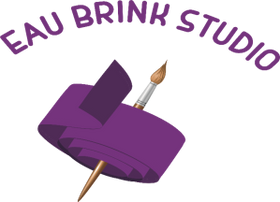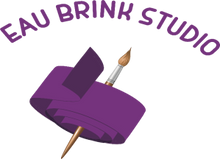A Grey Day at Sea: Finding Creative Focus Beyond the Horizon (with a Modern Twist)
There’s something quietly powerful about grey days by the sea—those muted tones, gentle light, and moments of stillness where the water and sky seem to merge into one. During a trip to the Faroe Islands, I found myself completely absorbed in these very qualities. I took three separate photographs during that trip—none of them especially dramatic on their own, but each with a sense of mood and memory I couldn’t shake.
Back in the studio, I began the process of turning those photos into something tangible—textile art that didn’t just show a place, but captured a feeling.
Layering Land and Sea: The Fabric Work
The finished piece you see above is a result of carefully combining those three images into a single layered scene. I began by choosing fabrics that mirrored the subdued palette of the Faroese coast: dusky blues, mossy greens, and soft greys. Organza gave me that semi-translucent, watery softness I needed for the sea, while cottons and finer textured fabrics created the solidity of rocks and sky.
Building the landscape was like painting with fabric. I layered the materials to give depth and light—light bouncing off water, shadows under the surface, and cloud shapes that softly glide above the land. It’s a meditative process, one where precision and intuition go hand in hand.
Free Motion Embroidery and Beading
Once the layers were in place, I began stitching. Free motion embroidery brings this kind of scene to life in ways nothing else can—those subtle waves, stitched in flowing lines, hint at movement; the hills gain contour and depth; even the clouds pick up a puff of texture as I stitch into them. It’s not just adding detail, it’s adding dimension.
After the stitching, I added small beads by hand. These are always optional, but for me, they give a quiet sparkle—mimicking the occasional glint of light on wet stones or that shimmer you catch on the sea's surface. They bring texture and a bit of magic to the finished piece.
From Handmade to Machine: Digitising the Work
Now here’s where tradition met technology.
After photographing the finished embroidery, I took it through the next phase: digitisation. Using image editing software, I cleaned up the photo and transformed it into a vector file. This step essentially breaks down the artwork into stitchable paths—simplifying details while preserving the essence of the original design.
From there, I converted the vector into a JEF file format—ready for my embroidery machine to interpret. Watching the machine begin to stitch out something that began as a collection of thoughts and images is, frankly, thrilling. The hum of the machine, the precision of the lines, the image forming again in a new medium—it’s complex, yes, but utterly satisfying.
The Dual Beauty of the Process
The result is twofold: I now have a richly textured original made by hand, and a clean, precise version stitched by machine—a kind of echo of the original, but with its own personality. Both versions hold value and beauty, each telling the same story in a slightly different language.
And more than that, this process allows me to share my work in a new way. The machine-stitched version can be repeated, gifted, sold, adapted. The handmade version is one of a kind. Together, they show what’s possible when we blend the traditional with the technological.
Final Thoughts
Yes—it’s a bit complicated. But every layered fabric, every line of stitch, and every digital conversion step plays its part. And when I stand back and watch that embroidery machine bring it to life—thread by thread—I’m reminded of why I do this.
Creativity doesn’t just come from inspiration. It comes from the willingness to experiment, to combine old skills with new tools, and to keep pushing until the piece feels just right.





Leave a comment